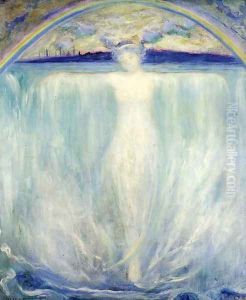Evelyn Rumsey-Carey Paintings
Evelyn Rumsey Carey, born in 1855 in Buffalo, New York, was an American artist and philanthropist notable for her contributions to both the arts and the public life of her city. Born into a prominent family, her father was Bronson Case Rumsey, a successful businessman and land developer, and her mother was Evelyn Kittredge Rumsey. Evelyn was the middle child, with four siblings. She grew up in an environment that valued education and culture, which laid the foundation for her artistic pursuits and civic engagement.
Evelyn was educated at the Buffalo Female Academy, now known as the Buffalo Seminary, and later pursued her artistic training more formally. She studied painting in Paris at the Académie Julian, a progressive art school that was one of the first to admit women students. There, she was influenced by the Impressionist movement and developed her own style that blended elements of Impressionism with more traditional academic painting techniques.
Her return to Buffalo marked the beginning of her active role in the cultural life of the city. She was instrumental in founding the Buffalo Society of Artists and played a key role in the Pan-American Exposition held in Buffalo in 1901. Perhaps her most famous contribution to the exposition was her design of the 'Spirit of Niagara' poster, which became an iconic image of the event. The poster showcased her skill in graphic design and her ability to capture the essence of the Niagara Falls, a symbol of natural beauty and power.
Beyond her artistic achievements, Evelyn Rumsey Carey was deeply involved in community service and philanthropy. She was a strong advocate for women's suffrage and was active in the women's club movement, which sought to provide women with opportunities for education, community service, and self-improvement. She also dedicated time and resources to the Visiting Nurses Association, which provided healthcare services to the poor.
Evelyn Rumsey Carey's life was a testament to the role that women played in the arts and public life at the turn of the 20th century. Her legacy as an artist and civic leader continues to be remembered in Buffalo and beyond. She passed away in 1924, leaving behind a rich legacy that has inspired subsequent generations of women artists and community activists.
